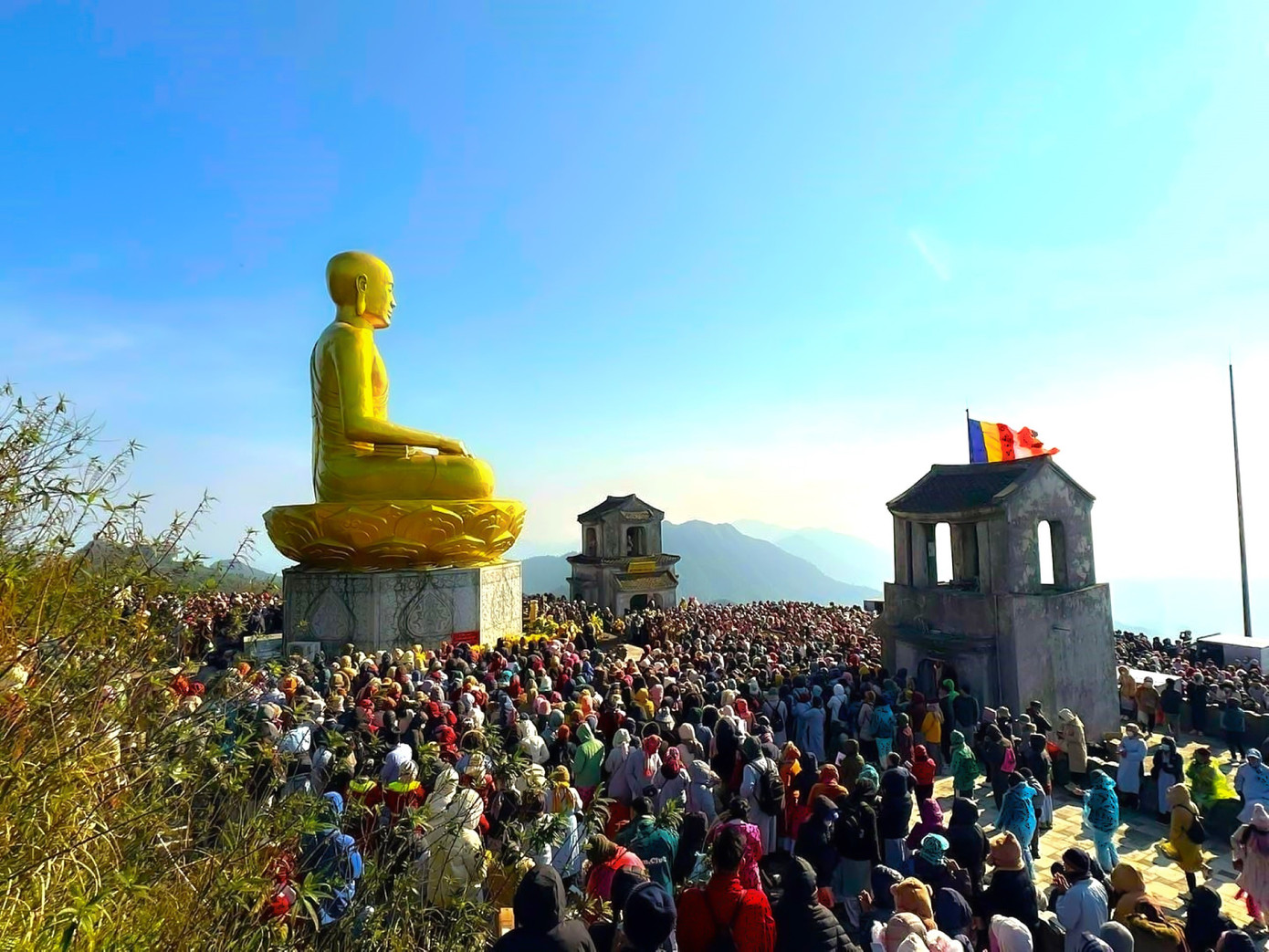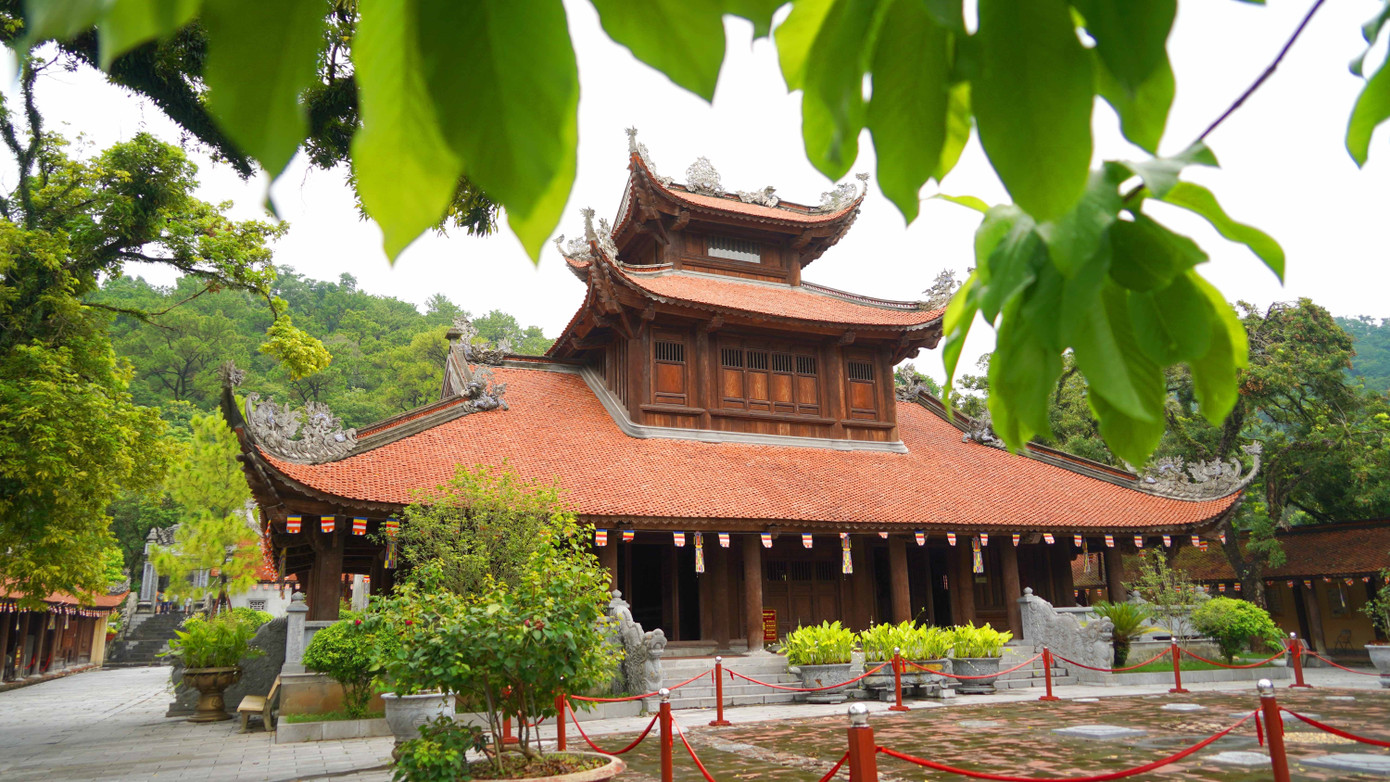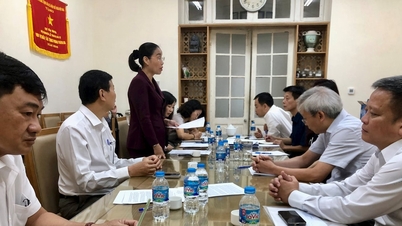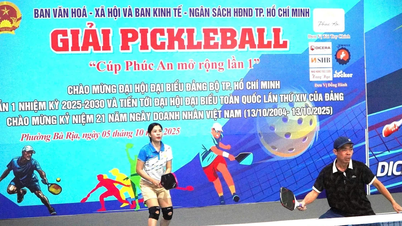Early morning on Tung Yen Tu road, the mist is like a layer of memory covering the stone steps. The bells from Hoa Yen mixed with the light scent of incense, the pilgrims' footsteps slowed down. No one mentioned the certificates or rankings.
Mountains are still mountains, rocks are still rocks. But behind that serenity are thirteen years of perseverance by people silently connecting words, connecting maps, connecting beliefs to bring the heritage on a long journey.
The journey of endurance
The idea of establishing a heritage profile for Yen Tu and further connecting the neighboring relic clusters into a whole was initiated in 2012. Two years later, the name Yen Tu appeared in the tentative list of the World Heritage Center. At that time, the vision of the heritage space was still very broad, many criteria were raised, many relic sites were grouped together.

Pressure to preserve Yen Tu, Vinh Nghiem, Con Son-Kiep Bac still exists due to passenger capacity limits.
IUCN and ICOMOS expert groups quietly came to Vietnam. They climbed mountains, waded through streams, visited pagodas, talked with temple keepers, management staff, and local people... The survey lasted for several weeks, passing through about two dozen relic sites, and then returned with a detailed report.
“Their candid comments silenced the domestic team. The most important thing was to cut through to create a coherent, cohesive and convincing story,” recalled Nguyen Thi Hanh, Vice Chairwoman of the Quang Ninh Provincial People’s Committee.
Since then, dozens of seminars and academic discussions have followed, hundreds of official documents have been exchanged between ministries and branches, including urgent recommendations sent to the Prime Minister . The narrative is anchored around the spirit of Truc Lam, with Yen Tu as the center, choosing Quang Ninh province as the "main force", and at the same time establishing the extended role of Vinh Nghiem and Con Son-Kiep Bac.
From more than 20 initial points, the dossier was condensed to 12 “key” points where landscape, history, religion and community meet to create an unbroken narrative.
In early 2024, a thick dossier was sent, including the main text of nearly a thousand pages and a detailed appendix system: photos, drawings, diagrams, zoning, management plan. Not only answering "why it is worthy", the dossier also pointed out "how to keep it". Hope was kindled. Then suddenly, ICOMOS released an evaluation report for the 47th session, recommending "defer" to postpone consideration, not to register at this session. Everything seemed to slow down.
During the mid-July days in Paris, the Vietnamese delegation lived almost exclusively within the narrow corridors of UNESCO headquarters. Technical groups met repeatedly to tighten the narrative around Truc Lam, eliminate insufficiently connected elements, and clarify problematic points regarding governance and authenticity.
“The turning point came from heritage diplomacy,” said Nguyen Thi Hanh. The Indian-led Committee and its co-authors proposed a revision to the draft decision, changing the opening line from “Defers” to “Inscribes.” The document then focused more clearly on the core sequential structure, emphasizing the globally outstanding value of the Truc Lam spirit.
Recalling the "brain-wrenching" meetings with representatives of member countries, Mr. Nguyen Viet Dung, Director of the Department of Culture, Sports and Tourism of Quang Ninh, is still emotional.
During a working session with a representative of a Middle Eastern country, after just a few stories, the delegate burst into tears because of admiration for the journey of Vietnam, a peace-loving nation that has persistently preserved its identity amidst turmoil.

Colorful clouds stretch across a strip on the top of Yen Tu
From the UNESCO corridor in Paris, the story returns to the mossy stone steps in Yen Tu, the woodblocks in Vinh Nghiem, the pine forests of Con Son, the sound of Luc Dau water in Kiep Bac. Thirteen years, many times it seemed like a dead end, but still kept going with perseverance and alertness.
Keep the flow of conservation
The title is recorded, the question begins to open, how to preserve and promote an inter-regional entity under the pressure of modern times? Preservation is not just about building fences and hanging signs. Preservation is about treating time properly.
“In Yen Tu, the old stone steps need to be respected as a film of the footsteps of generations. The restoration of the road to the pagoda needs to prioritize traditional materials, structures and landscapes, and limit the leveling that makes the mountain lose its “breathing”.
Forests are the lungs of heritage, the system of monitoring forest fires, erosion, and seasonal passenger loading must become a permanent process, linked to the livelihoods of indigenous communities," said Mr. Pham Ngoc Thuc, 88 years old, who has many years of research on Quang Ninh culture.
Not only Yen Tu, but also Vinh Nghiem, Bo Da or Con Son-Kiep Bac and other sites in the recognized heritage complex also need to be carefully and systematically planned for conservation. In the dossier submitted to UNESCO, there are nearly 1,000 pages, of which more than 30% is the direction for conservation and promotion of values after recognition.
With a system of more than 3,000 woodblocks, “wood archives”, there will be a systematic program of preservation and digitization. Because each knife mark, each worn edge of the board is a layer of knowledge. Digitization is not to replace experience, but to preserve and disseminate.
Historical reenactment activities always adhere to documents, increasing academic depth. The system of relics in the spatial system linking from Con Son-Kiep Bac to Kinh Chu cave, Yen Giang stake field has a common, consistent explanatory language.

Con Son Pagoda is quiet among the green pine forest
“Tourism growth is real, but cultural benefits are what last long. A paved road can make a photo more beautiful, but if we erase the ancient stone steps, we have erased a part of the memory. A bustling service area can be bustling for a season, but if we drown out the sound of temple bells, we have encroached on the blood vessels of heritage. Knowing where to stop is also a manifestation of conservation civilization,” said Mr. Pham Ngoc Thuc.
In particular, this is an inter-provincial heritage, the story does not stop at one locality. The three parties of Quang Ninh, Bac Ninh, and Hai Phong need a flexible and binding coordination mechanism, unifying the passenger load limit, tour route, signs, stops, and standards for restoration materials.
Share open data banks on books, inscriptions, and archaeology. Train tour guides to “tell stories” rather than just “count facts”. When each link understands its place in the overall symphony, the heritage is not “fragmented”, but resonates.
UNESCO is not the finish line. It is the comma that opens the next part of the persistent and anonymous work. Continue to research, digitize, train, coordinate, protect forests, protect streams, and maintain pilgrimage traditions. The name may change today, but the old path remains. The only question is whether we can keep up with the pace. And that is the contemporary responsibility that the World Heritage title has placed in each of us.
Source: https://tienphong.vn/theo-dau-chan-phat-hoang-tu-danh-hieu-di-san-den-trach-nhiem-bao-ton-post1778478.tpo






![[Photo] Prime Minister Pham Minh Chinh chairs the 16th meeting of the National Steering Committee on combating illegal fishing.](https://vphoto.vietnam.vn/thumb/1200x675/vietnam/resource/IMAGE/2025/10/07/1759848378556_dsc-9253-jpg.webp)
































![[Photo] Super harvest moon shines brightly on Mid-Autumn Festival night around the world](https://vphoto.vietnam.vn/thumb/1200x675/vietnam/resource/IMAGE/2025/10/07/1759816565798_1759814567021-jpg.webp)
























































Comment (0)